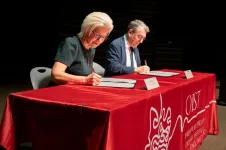(Press-News.org) Researchers have developed tiny, flexible devices that can wrap around individual nerve fibres without damaging them.
The researchers, from the University of Cambridge, combined flexible electronics and soft robotics techniques to develop the devices, which could be used for the diagnosis and treatment of a range of disorders, including epilepsy and chronic pain, or the control of prosthetic limbs.
Current tools for interfacing with the peripheral nerves – the 43 pairs of motor and sensory nerves that connect the brain and the spinal cord – are outdated, bulky and carry a high risk of nerve injury. However, the robotic nerve ‘cuffs’ developed by the Cambridge team are sensitive enough to grasp or wrap around delicate nerve fibres without causing any damage.
Tests of the nerve cuffs in rats showed that the devices only require tiny voltages to change shape in a controlled way, forming a self-closing loop around nerves without the need for surgical sutures or glues.
The researchers say the combination of soft electrical actuators with neurotechnology could be an answer to minimally invasive monitoring and treatment for a range of neurological conditions. The results are reported in the journal Nature Materials.
Electric nerve implants can be used to either stimulate or block signals in target nerves. For example, they might help relieve pain by blocking pain signals, or they could be used to restore movement in paralysed limbs by sending electrical signals to the nerves. Nerve monitoring is also standard surgical procedure when operating in areas of the body containing a high concentration of nerve fibres, such as anywhere near the spinal cord.
These implants allow direct access to nerve fibres, but they come with certain risks. “Nerve implants come with a high risk of nerve injury,” said Professor George Malliaras from Cambridge’s Department of Engineering, who led the research. “Nerves are small and highly delicate, so anytime you put something large, like an electrode, in contact with them, it represents a danger to the nerves.”
“Nerve cuffs that wrap around nerves are the least invasive implants currently available, but despite this they are still too bulky, stiff and difficult to implant, requiring significant handling and potential trauma to the nerve,” said co-author Dr Damiano Barone from Cambridge’s Department of Clinical Neurosciences.
The researchers designed a new type of nerve cuff made from conducting polymers, normally used in soft robotics. The ultra-thin cuffs are engineered in two separate layers. Applying tiny amounts of electricity – just a few hundred millivolts – causes the devices to swell or shrink.
The cuffs are small enough that they could be rolled up into a needle and injected near the target nerve. When activated electrically, the cuffs will change their shape to wrap around the nerve, allowing nerve activity to be monitored or altered.
“To ensure the safe use of these devices inside the body, we have managed to reduce the voltage required for actuation to very low values,” said Dr Chaoqun Dong, the paper’s first author. “What's even more significant is that these cuffs can change shape in both directions and be reprogrammed. This means surgeons can adjust how tightly the device fits around a nerve until they get the best results for recording and stimulating the nerve.”
Tests in rats showed that the cuffs could be successfully placed without surgery, and they formed a self-closing loop around the target nerve. The researchers are planning further testing of the devices in animal models, and are hoping to begin testing in humans within the next few years.
“Using this approach, we can reach nerves that are difficult to reach through open surgery, such as the nerves that control, pain, vision or hearing, but without the need to implant anything inside the brain,” said Barone. “The ability to place these cuffs so they wrap around the nerves makes this a much easier procedure for surgeons, and it’s less risky for patients.”
“The ability to make an implant that can change shape through electrical activation opens up a range of future possibilities for highly targeted treatments,” said Malliaras. “In future, we might be able to have implants that can move through the body, or even into the brain – it makes you dream how we could use technology to benefit patients in future.”
The research was supported in part by the Swiss National Science Foundation, the Cambridge Trust, and the Engineering and Physical Sciences Research Council (EPSRC), part of UK Research and Innovation (UKRI).
END
Robotic nerve ‘cuffs’ could help treat a range of neurological conditions
2024-04-26
ELSE PRESS RELEASES FROM THIS DATE:
Researchers identify targets in the brain to modulate heart rate and treat depressive disorders
2024-04-26
Study led by Brigham investigators suggests heart rate may be a useful tool to determine where to stimulate the brains of individuals with depressive disorders when brain scans aren’t available
A new study by researchers at Brigham and Women’s Hospital, a founding member of the Mass General Brigham healthcare system, suggests a common brain network exists between heart rate deceleration and depression. By evaluating data from 14 people with no depression symptoms, the team found stimulating some parts of the brain linked to depression with transcranial magnetic stimulation ...
Findings of large-scale study on 572 Asian families supports gene-directed management of BRCA1 and BRCA2 gene carriers in Singapore
2024-04-26
Singapore, 26 April 2024 – A team of clinician-scientists and scientists from the University of Nottingham (Malaysia campus), National Cancer Centre Singapore (NCCS), Cancer Research Malaysia, Nanyang Technological University, Singapore (NTU Singapore), University of Malaya, University of Cambridge, A*STAR’s Genome Institute of Singapore (GIS) and other institutions, have conducted the largest study done to date of BRCA1 and BRCA2 (BReast CAncer Gene 1 and 2) carriers in an Asian population and refined breast and ovarian cancer risk estimates for this population. The findings, ...
Many children with symptoms of brain injuries and concussions are missing out on vital checks, national US study finds
2024-04-26
Almost a quarter of US children with symptoms of a brain injury or concussion are not checked for the condition, with younger children particularly likely to be overlooked, a new national study finds.
The peer-reviewed US research, which is published in the journal Brain Injury, also shows that children with symptoms or a diagnosis of a brain injury or concussion were more likely to have symptoms of depression than other youngsters. They also found it harder to make friends.
Routine checks would help ensure such children receive the care that they need, says ...
Genetic hope in fight against devastating wheat disease
2024-04-26
Fungal disease Fusarium head blight (FHB) is on the rise due to increasingly humid conditions induced by climate change during the wheat growing season, but a fundamental discovery by University of Adelaide researchers could help reduce its economic harm.
While some types of wheat are resistant to FHB thanks to the action of the TaHRC gene at the Fhb1 locus, how this gene functions in wheat cells was unknown until now.
Collaborating with Nanjing Agriculture University, the University of Adelaide research team has shown TaHRC works in the nucleus of wheat cells, ...
Mutualism, from biology to organic chemistry?
2024-04-26
Heteroatom tin compounds (SSn, OSn, NSn, PSn) composed of heteroatoms S, O, N, P and tin atoms have attracted intense attention due to their wide applications in organic synthesis and pharmaceutical fields. The current methods for synthesis of such compounds, such as metathesis reactions, addition reactions, and free radical reactions, exhibit drawbacks including narrow substrate scope and harsh conditions. Therefore, it is important to develop efficient synthetic systems to construct heteroatom-tin bond.
Tetrahydroquinoline, as an important ...
POSTECH Professor Yong-Young Noh resolves two decades of oxide semiconductor challenges, which Is published in prestigious journal Nature
2024-04-26
Professor Yong-Young Noh from the Department of Chemical Engineering at Pohang University of Science and Technology (POSTECH), along with Dr. Ao Liu and Dr. Huihui Zhu, postdoctoral researchers from the Department of Chemical Engineering at POSTECH and now professors at the University of Electronic Science and Technology of China, Dr. Yong-Sung Kim from Korea Research Institute of Standards and Science, and Dr. Min Gyu Kim from the Pohang Accelerator Laboratory, collaborated on the development of a tellurium-selenium composite oxide semiconductor material. Their efforts led to the successful creation of a high-performance and highly ...
Could fishponds help with Hawaiʻi’s food sustainability?
2024-04-26
Indigenous aquaculture systems in Hawaiʻi, known as loko iʻa or fishponds, can increase the amount of fish and fisheries harvested both inside and outside of the pond. This is the focus of a study published by a team of researchers at the University of Hawaiʻi at Mānoa Hawaiʻi Institute of Marine Biology (HIMB). Today, aquaculture supplies less than 1% of Hawaiʻi’s 70 million pounds of locally available seafood, but revitalization of loko i‘a has the potential to significantly increase locally available seafood.
According to historical accounts, loko ...
International network in Asia and Europe to uncover the mysteries of marine life
2024-04-26
The Okinawa Institute of Science and Technology (OIST) and France’s National Centre for Scientific Research (CNRS) have signed a letter of intent to work towards establishing an international research lab and agreeing on comprehensive academic collaboration.
The signing ceremony took place during the opening session of the OIST-CNRS Joint Symposium on West Pacific Marine Biology on April 23. Dr. Karin Markides, President and CEO, and Professor Vincent Laudet were among the speakers from OIST, and they were joined by representatives from CNRS, namely Dr. André ...
Anthropologist documents how women and shepherds historically reduced wildfire risk in Central Italy
2024-04-26
In the last several decades, large forest fires have increasingly threatened communities across the Mediterranean. Climate change is expected to make these fires larger, hotter, and more dangerous in the future. But fire management lessons from the past could help to improve the resilience of local landscapes.
The latest research paper from environmental anthropologist and University of California, Santa Cruz Professor Andrew Mathews explores these issues in the Monte Pisano region of Central Italy. In particular, Mathews found that peasant women, who historically collected ...
Living at higher altitudes in India linked to increased risk of childhood stunting
2024-04-26
Living at higher altitudes in India is linked to an increased risk of stunted growth, with children living in homes 2000 metres or more above sea level 40% more at risk than those living 1000 metres below, finds research published in the open access journal BMJ Nutrition Prevention & Health.
Children living in rural areas seem to be the most vulnerable, prompting the researchers to advocate prioritising nutritional programmes in hilly and mountainous regions of the country.
Despite ...





